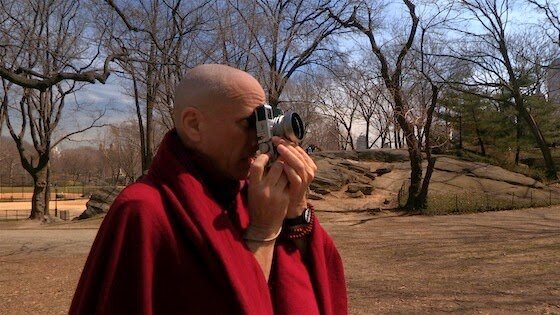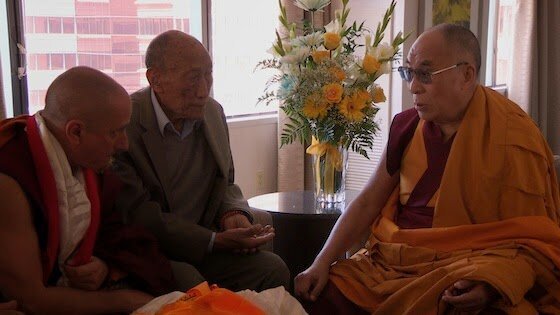Blog
MLK Birthday
Gordon Parks
I was raised in Mobile, Alabama. Today, on Martin Luther King's birthday, I happened upon a Gordon Parks photo - a true miracle. “Ondria Tanner and Her Grandmother Window-shopping, Mobile, Alabama,” (1956). Mr. Parks has captured the feel and texture of that time in Alabama.
This photo was taken at the entrance of my family's department store.
Segregation Story: Gordon Parks continues at Salon 94 Bowery (243 Bowery, Lower East Side, Manhattan) through January 17. Photos from the same series are currently also on view in Gordon Parks: A Segregation Story 1956 at Rhona Hoffman Gallery (118 North Peoria Street, Chicago) through February 20.
Monk With A Camera
I had the great pleasure to see the magnificent movie, "Monk With A Camera". Seeing Nicolas Vreeland's spiritual journey was inspiring in this intimate and honest documentary.
Nicholas Vreeland walked away from a worldly life of privilege to become a Tibetan Buddhist monk. Grandson of legendary Vogue editor, Diana Vreeland, and trained by Irving Penn to become a photographer, Nicholas' life changed drastically upon meeting a Tibetan master, one of the teachers of the Dalai Lama. Soon thereafter, he gave up his glamorous life to live in a monastery in India, where he studied Buddhism for fourteen years. In an ironic twist of fate, Nicholas went back to photography to help his fellow monks rebuild their monastery. Recently, the Dalai Lama appointed Nicholas as Abbot of the monastery, making him the first Westerner in Tibetan Buddhist history, to attain such a highly regarded position.
Nicky Vreeland's photos can be viewed. Please click to see portfolio.
Louise Bourgeois: Suspension
Louise Bourgeois LEGS 2001 Fabric 76 x 34 x 22 1/2 inches 193 x 86.4 x 57.2 centimeters
I am most interested in mature artists making great works throughout their careers and especially in their later years. Often artist’s work can be considered better as they evolve.
The recent show Louise Bourgeois: Suspension at Cheim & Read (October 30, 2014 - January 10, 2015) is a fine example of greatness in later years. Many of the art works found in this show were created when Bourgeois was 91 years young.
The sculptures in this magnificent exhibition all hang from the ceiling. Along with a group of drawings from the 1940s, in which pendulous forms are delineated in black ink, the selection of works traces the theme of suspension throughout Bourgeois’s long career. Spanning more than forty-five years – from the organic Lair forms of the early 1960s and the Janus series of 1968, to the cloth figures of the 1990s, the hanging heads of the 2000s, and the torqued spirals of shining aluminum made in the last years of Bourgeois’s life – they demonstrate the myriad ways in which she approached material, form, and scale.
Most interesting is her explanation and approach to the works. For Bourgeois, the sculptures’ suspension is an expression of the psyche; as she stated: “Horizontality is a desire to give up, to sleep. Verticality is an attempt to escape. Hanging and floating are states of ambivalence.”
In psychology, ambivalence refers to conflicting but coexisting feelings for the same person, place, or event.
I found the hanging pieces and the installation very playful and humorous in spite of the artist’s serious references. The technical execution of each sculpture is absolutely beautiful.
It was truly a wonderful moment with a great artist, Louise Bourgeois (1911-2010).
Degenerate Art: The Attack on Modern Art in Nazi Germany, 1937
Ernst Ludwig Kirchner A Group of Artists (The Painters of the Brücke), 1925-26 Oil on canvas Museum Ludwig, Cologne Photo: © Rheinisches Bildarchiv Cologne
March 13-September 1, 2014
I saw the exhibition this week and was speechless. I saw some of the greatest works by the most prominent artists in art history. The show at the Neue Galerie is truly a gift to the NYC.
On March 13, 2014 Neue Galerie New York opened the exhibition "Degenerate Art: The Attack on Modern Art in Nazi Germany, 1937." This is the first major U.S. museum exhibition devoted to the infamous display of modern art by the Nazis since the 1991 presentation at the Los Angeles County Museum of Art.
The term "degenerate" was adopted by the National Socialist regime as part of its campaign against modern art. Many works branded as such by the Nazis were seized from museums and private collections. Following the showing on these works in a three-year traveling exhibition that criss-crossed Germany and Austria, most were sold, lost, or presumed destroyed. In this light, the recent discovery in Munich of the Gurlitt trove of such artwork has attracted considerable attention. The film "The Monuments Men,"directed by George Clooney, is about this amazing moment in history and shows the growing interest in the subject.
Max Beckmann Departure, 1932-1935 oil on canvas The Museum of Modern Art, New York. Given anonymously (by exchange) Digital Image © 2014 The Museum of Modern Art/Licensed by SCALA/Art Resource, NY © 2014 Artists Rights Society (ARS), New York/VG Bild-Kunst, Bonn
Highlights of the show include a number of works shown in Munich in the summer of 1937, such as Max Beckmann's Cattle in a Barn (1933); George Grosz's Portrait of Max Hermann-Neisse (1925); Erich Heckel's Barbershop (1913); Ernst Ludwig Kirchner's Winter Landscape in Moonlight (1919), The Brücke-Artists (1926/27); Paul Klee's The Angler (1921), The Twittering Machine (1922), and Ghost Chamber with the Tall Door (1925); Oskar Kokoschka's The Duchess of Montesquiou-Fezensac (1910); Ewald Mataré's Lurking Cat (1928); Karel Niestrath's Hungry Girl (1925); Emil Nolde's Still-Life with Wooden Figure (1911), Red-Haired Girl (1919), and Milk Cows (1913); Christian Rohlf's The Towers of Soes (ca. 1916) and Acrobats (ca. 1916); Karl Schmidt-Rottluff's Pharisees (1912); and Lasar Segall's The Eternal Wanderers (1919), among others.
The Neue Galerie exhibition is accompanied by a fully-illustrated catalogue published by Prestel Verlag.
Neue Galerie New York
Museum for German and Austrian Art
1048 Fifth Avenue
New York, NY 10028
Commemorating WTC in Scarf Line for 9/11 Museum






By Gina Rose Sirico
on May 15, 2014
“Liberty Between the Towers” photograph by Paula Barr
New York – Paula Barr, a world-renown photographer known for her images of iconic New York, has licensed Collection 18 to reproduce two of her images of the World Trade Center on a silk scarves to be sold exclusively at the 9/11 Memorial Museum Retail Store.
“Lunchtime on the WTC Plaza” photograph by Paula Barr
Barr was commissioned by the Port Authority of New York and New Jersey in the late 1980s to photograph the most important images of New York City, which included the World Trade Center, The Empire State Building, The Statue of Liberty, The Bridges of New York, and more.
The first scarf is based upon a color photograph titled, “Liberty Between the Towers,” which Barr shot from an abandoned pier to capture Lady Liberty centered between the two World Trade Towers. It shows the skyline of the city on a beautiful day. The second print on a scarf is a black and white photograph called, “Lunchtime on the WTC Plaza,” depicting visitors and workers gathering on the World Trade Center’s plaza in 1986.
The scarves will retail for $95 and will be sold at the 9/11 Memorial Retail Store at the 9/11 Memorial Museum, which opens May 21. The scarves will also be available at 9/11 Memorial Store
9/11 Museum Exclusive Silk Scarves
This scarf is a Paula Barr panoramic photograph, entitled "Liberty Between the Towers". The skyline image was taken from an abandoned pier in New Jersey in order to capture Lady Liberty precisely between the Twin Towers on a beautiful day. The 100% silk scarf measures 22 x 72 inches.
This scarf features Paula Barr's panoramic photograph, entitled "Lunchtime on the WTC Plaza," of downtown workers and visitors gathering on the World Trade Center's plaza, which sometimes served as a public space for concerts and other outd
oor programs. The vast scale of the Twin Towers, the reflective surfaces and striking gothic arches created by the steel tridents inspired photographers to depict them from every perspective. Two tridents recovered from the North Tower now stand in the Museum Pavilion. The 100% silk scarf measures 22 x 72 inches.








